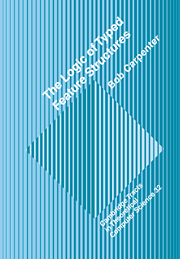 The Logic of Typed Feature Structures
The Logic of Typed Feature Structures 3 - Feature Structures
Published online by Cambridge University Press: 12 October 2009
Summary
With our definition of inheritance, we have a notion of consistency and unification for our smallest conceptual unit, the type. We now turn to the task of developing structured representations that can be built out of the basic concepts, which we call feature structures. The reason for the qualifier is that even though feature structures are defined using our type symbols, they are not typed, in the sense that there is no restriction on the co-occurrence of features or restrictions on their values. We introduce methods for specifying appropriateness conditions on features and a notion of well-typing only after studying the ordered notion of feature structures. We also hold off on introducing inequations and extensionality conditions. Before introducing these other topics, we concentrate on fully developing the notion of untyped feature structure and the logical notions we employ. Most of the results that hold for feature structures can be immediately generalized to well-typed feature structures by application of the type inference mechanism.
Our feature structures are structurally similar to the more traditional form of feature structures such as those used in the patr-ii system and those defined by Rounds and Kasper. The next major development after these initial systems was introduced by Moshier (1988). The innovation of Moshier's system was to allow atomic symbols to label arbitrary nodes in a feature structure. He also treated the identity conditions for these atoms fully intensionally. Both patr-ii and the Rounds and Kasper systems treated feature structures intensionally, but enforced extensional identity conditions on atoms.
- Type
- Chapter
- Information
- The Logic of Typed Feature StructuresWith Applications to Unification Grammars, Logic Programs and Constraint Resolution, pp. 33 - 50Publisher: Cambridge University PressPrint publication year: 1992
